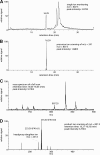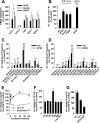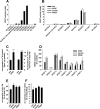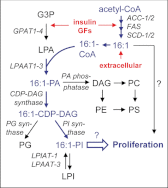Palmitoleate is a mitogen, formed upon stimulation with growth factors, and converted to palmitoleoyl-phosphatidylinositol
- PMID: 22700983
- PMCID: PMC3411066
- DOI: 10.1074/jbc.M111.274829
Palmitoleate is a mitogen, formed upon stimulation with growth factors, and converted to palmitoleoyl-phosphatidylinositol
Abstract
Controversial correlations between biological activity and concentration of the novel lipokine palmitoleate (9Z-hexadecenoate, 16:1) might depend on the formation of an active 16:1 metabolite. For its identification, we analyzed the glycerophospholipid composition of mouse Swiss 3T3 fibroblasts in response to 16:1 using LC-MS/MS. 16:1 was either supplemented to the cell culture medium or endogenously formed when cells were stimulated with insulin or growth factors as suggested by the enhanced mRNA expression of 16:1-biosynthetic enzymes. The proportion of 1-acyl-2-16:1-sn-phosphatidylinositol (16:1-PI) was time-dependently and specifically increased relative to other glycerophospholipids under both conditions and correlated with the proliferation of fatty acid (16:1, palmitate, oleate, or arachidonate)-supplemented cells. Accordingly, cell proliferation was impaired by blocking 16:1 biosynthesis using the selective stearoyl-CoA desaturase-1 inhibitor CAY10566 and restored by supplementation of 16:1. The accumulation of 16:1-PI occurred throughout cellular compartments and within diverse mouse cell lines (Swiss 3T3, NIH-3T3, and 3T3-L1 cells). To elucidate further whether 16:1-PI is formed through the de novo or remodeling pathway of PI biosynthesis, phosphatidate levels and lyso-PI-acyltransferase activities were analyzed as respective markers. The proportion of 16:1-phosphatidate was significantly increased by insulin and growth factors, whereas lyso-PI-acyltransferases showed negligible activity for 16:1-coenzyme A. The relevance of the de novo pathway for 16:1-PI biosynthesis is supported further by the comparable incorporation rate of deuterium-labeled 16:1 and tritium-labeled inositol into PI for growth factor-stimulated cells. In conclusion, we identified 16:1 or 16:1-PI as mitogen whose biosynthesis is induced by growth factors.
Figures






Similar articles
-
Acetylcholine stimulates selective liberation and re-esterification of arachidonate and accumulation of inositol phosphates and glycerophosphoinositol in C62B glioma cells.J Biol Chem. 1987 Jun 15;262(17):8077-83. J Biol Chem. 1987. PMID: 3110145
-
Uptake of exogenous sn-1-acyl-2-lyso-phosphatidylinositol into HeLa S3 cells. Reacylation on the cell surface and metabolism to glucosaminyl(acyl)phosphatidylinositol.J Biol Chem. 1995 Apr 21;270(16):9147-53. doi: 10.1074/jbc.270.16.9147. J Biol Chem. 1995. PMID: 7721829
-
Role of p38 mitogen-activated protein kinase in linking stearoyl-CoA desaturase-1 activity with endoplasmic reticulum homeostasis.FASEB J. 2015 Jun;29(6):2439-49. doi: 10.1096/fj.14-268474. Epub 2015 Feb 12. FASEB J. 2015. PMID: 25678624
-
Glycerophospholipid metabolism: back to the future.Thromb Res. 1992 Aug 1;67(3):313-23. doi: 10.1016/0049-3848(92)90006-v. Thromb Res. 1992. PMID: 1329260 Review.
-
Regulation of stearoyl-CoA desaturase genes: role in cellular metabolism and preadipocyte differentiation.Biochem Biophys Res Commun. 1999 Dec 9;266(1):1-4. doi: 10.1006/bbrc.1999.1704. Biochem Biophys Res Commun. 1999. PMID: 10581155 Review.
Cited by
-
The n-10 Fatty Acids Family in the Lipidome of Human Prostatic Adenocarcinoma Cell Membranes and Extracellular Vesicles.Cancers (Basel). 2020 Apr 7;12(4):900. doi: 10.3390/cancers12040900. Cancers (Basel). 2020. PMID: 32272739 Free PMC article.
-
The Hypoxic Microenvironment Induces Stearoyl-CoA Desaturase-1 Overexpression and Lipidomic Profile Changes in Clear Cell Renal Cell Carcinoma.Cancers (Basel). 2021 Jun 13;13(12):2962. doi: 10.3390/cancers13122962. Cancers (Basel). 2021. PMID: 34199164 Free PMC article.
-
Diversity and function of membrane glycerophospholipids generated by the remodeling pathway in mammalian cells.J Lipid Res. 2014 May;55(5):799-807. doi: 10.1194/jlr.R046094. Epub 2014 Mar 19. J Lipid Res. 2014. PMID: 24646950 Free PMC article. Review.
-
PPARγ Agonists Attenuate Palmitate-Induced ER Stress through Up-Regulation of SCD-1 in Macrophages.PLoS One. 2015 Jun 10;10(6):e0128546. doi: 10.1371/journal.pone.0128546. eCollection 2015. PLoS One. 2015. PMID: 26061913 Free PMC article.
-
Roles of Palmitoleic Acid and Its Positional Isomers, Hypogeic and Sapienic Acids, in Inflammation, Metabolic Diseases and Cancer.Cells. 2022 Jul 8;11(14):2146. doi: 10.3390/cells11142146. Cells. 2022. PMID: 35883589 Free PMC article. Review.
References
-
- Shindou H., Shimizu T. (2009) Acyl-CoA:lysophospholipid acyltransferases. J. Biol. Chem. 284, 1–5 - PubMed
-
- Kent C. (1995) Eukaryotic phospholipid biosynthesis. Annu. Rev. Biochem. 64, 315–343 - PubMed
-
- Warensjö E., Ohrvall M., Vessby B. (2006) Fatty acid composition and estimated desaturase activities are associated with obesity and lifestyle variables in men and women. Nutr. Metab. Cardiovasc. Dis. 16, 128–136 - PubMed
-
- Paillard F., Catheline D., Duff F. L., Bouriel M., Deugnier Y., Pouchard M., Daubert J. C., Legrand P. (2008) Plasma palmitoleic acid, a product of stearoyl-CoA desaturase activity, is an independent marker of triglyceridemia and abdominal adiposity. Nutr. Metab. Cardiovasc. Dis. 18, 436–440 - PubMed
Publication types
MeSH terms
Substances
LinkOut - more resources
Full Text Sources
Research Materials
Miscellaneous

